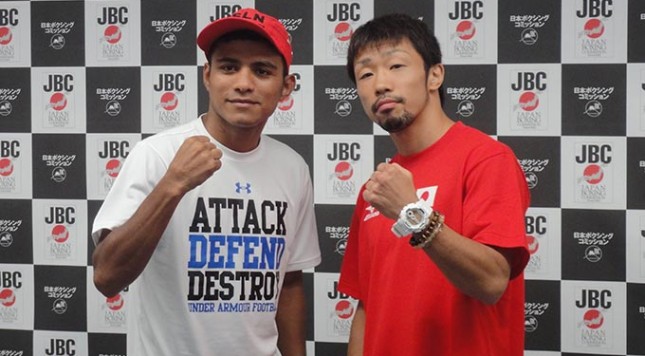By every measurement save one, this should be among the most highly anticipated boxing weekends of 2014. No, not because of Showtime’s showcase tripleheader, obviously. The real high-level action is taking place far up the television dial in the United States, or else nowhere to be found at all.
That’s because the men who are providing this high-level action fall short in the one measurement that makes even some hardcore fans turn into snobs who don’t care about dramatic brawls between the sport’s elite: size.
The flyweight division has been in something of a golden age, stacked deep with quality fighters who are (gasp!) actually fighting one another, and producing classics when they do. Friday in Tokyo, the surprisingly potent champion of the division, Akira Yaegashi (above right), is showing more nerve than men literally twice his size in taking on the king who was foretold, Roman Gonzalez (left). The next day in Mexico City, Juan Francisco Estrada, who made his name with a stiff challenge against Gonzalez and has since proven that he’s no one-hit wonder, takes on the always menacing Giovani Segura.
Combined, they are four of the best boxers at 112 pounds. Not a one of them have been in a bad fight. Gonzalez and Estrada are both, at minimum, top 20 in the world regardless of weight, and with wins this weekend they could rocket even higher.
Yet while boxing writers are salivating over the two bouts, while many hardcore fans are counting the weekend as one of their rare lucky stars, the two fights will still be invisible in the United States, in large measure owing to the obscurity of the beIN Sports Espanol network televising Estrada-Segura and the complete lack of television coverage of Gonzalez-Yaegashi.
The littler men of the sport don’t have a big track record of doing big TV ratings here they way they do in Japan or Mexico, which is probably why the bigger networks passed. There is an obvious chicken vs. egg problem here: Without regular exposure to the smaller divisions, fans aren’t going to be able to “get into” them. Each of these fights didn’t need to headline on HBO or Showtime, however — they could’ve served as very appealing warm-ups for the bigger divisions. Unfortunately, it’s also the case that some fans have trouble imagining how much of a badass these shorter, lighter boxers are when they are 5’3″ and weigh little more than supermodels.
It’s their loss, and then, by extension, ours.
The fights themselves, it must be said, do have clear favorites, and ought to. But both of the underdogs, Yaegashi and Segura, have proven more than once that they shouldn’t be underestimated.
Yaegashi achieved what prominence he has in the boxing world with a 2011 Fight of the Year win over Pornsawan Porpramook at 105 pounds, then lost another action fight to Kazuto Ioka. The move up to 112 pounds didn’t figure to be a smart one, but he knocked off one of the weaker lineal champions in the sport, Toshiyuki Igarashi (who earned the throne with a defeat of the even weaker champion Sonny Boy Jaro), then spoiled Edgar Sosa’s Fighter of the Year candidacy in 2013 by showing off startling boxing ability against a man viewed as the better technician.
The ultra-crude Segura makes pre-Sosa Yaegashi look like Mikhail Baryshnikov, yet he has shown you can get a lot done with wild, heavy punches and resilience. He lost at light flyweight Cesar Canchila then avenged that same loss, and took out the class of the lighter divisions with two knockouts of the actually balletic Ivan Calderon. A move up to flyweight brought losses to Brian Viloria and Sosa that suggested his megatons of power at 108 became mere kilotons at 112, only for him to reestablish himself against prospect Jonathan Gonzalez and, more dramatically, with a final round stoppage of longtime flyweight contender Hernan Marquez.
Both Gonzalez and Estrada have better wins, is all, with fewer setbacks and styles battle-tested against all kinds. As mentioned before, even Estrada’s most well-known setback — a loss to Gonzalez — said an awful lot about how good he was. Gonzalez is a power puncher who can box, a tinier version of the ultra-feared Gennady Golovkin and Sergey Kovalev, only if they were both faster. If there’s any question about him coming into this fight, it’s whether his knockout run since moving up to 112 last year is more about who he beat than whether his power translates at flyweight. That’s not much of a question; it’s not like other guys are plowing through even the caliber of opponent Gonzalez has faced at 112. Estrada, too, is a mean boxer-puncher, whose frame appears to have benefited from a move up to flyweight, if anything. The major difference between the two is that Estrada operates better at range and Gonzalez likes to get in close.
Making matters worse for Yaegashi and Segura is that they are both over 30, a bad age for smaller fighters, against opponents in their primes. Gonzalez and Estrada have shown little vulnerability of late. There’s not a lot for the elder pair to pin their hopes on. Yaegashi has to hope he can outbox Gonzalez or, otherwise, prove he doesn’t belong in the ring with an elite flyweight. Segura has to hope he can catch Estrada with some knockout shots, or, otherwise, make ample use of his rock-solid chin (he was only stopped by Viloria thanks to a swollen eye) en route to outworking the younger man.
Despite the favorite status of Gonzalez and Estrada, these bouts will deliver two-way brutality as long as they last. Those who make an effort to find them — and it’s tragic that they’ll have to work for it — will be spoiled by their own good taste.

